Detailed Analytical Report on Coca-Cola Company's Supply Chain
VerifiedAdded on 2021/06/14
|18
|3916
|536
Report
AI Summary
This analytical report provides a comprehensive overview of the Coca-Cola Company's procurement and supply chain. It examines the company's mission, vision, and strategic goals, followed by detailed findings on supply analysis, operational analysis, information analysis, integration analysis, and sustainability analysis. The report explores key product and supplier analysis, forecasting techniques, inventory management, and the impact of the bullwhip effect. It also highlights the company's use of IT tools, collaborative practices, and the Triple As of the supply chain. Furthermore, it offers recommendations on how programs like ERP and RFI can assist the company in achieving its objectives and overcoming challenges such as competition and health issues. The report concludes with a summary of the company's supply chain analysis and improvement programs.

Running Head: ANALYTICAL REPORT OF COCA-COLA COMPANY
1
Analytical Report of Coca Cola Company
Name
Class
Instructor
Institute Affiliation
Date
1
Analytical Report of Coca Cola Company
Name
Class
Instructor
Institute Affiliation
Date
Paraphrase This Document
Need a fresh take? Get an instant paraphrase of this document with our AI Paraphraser
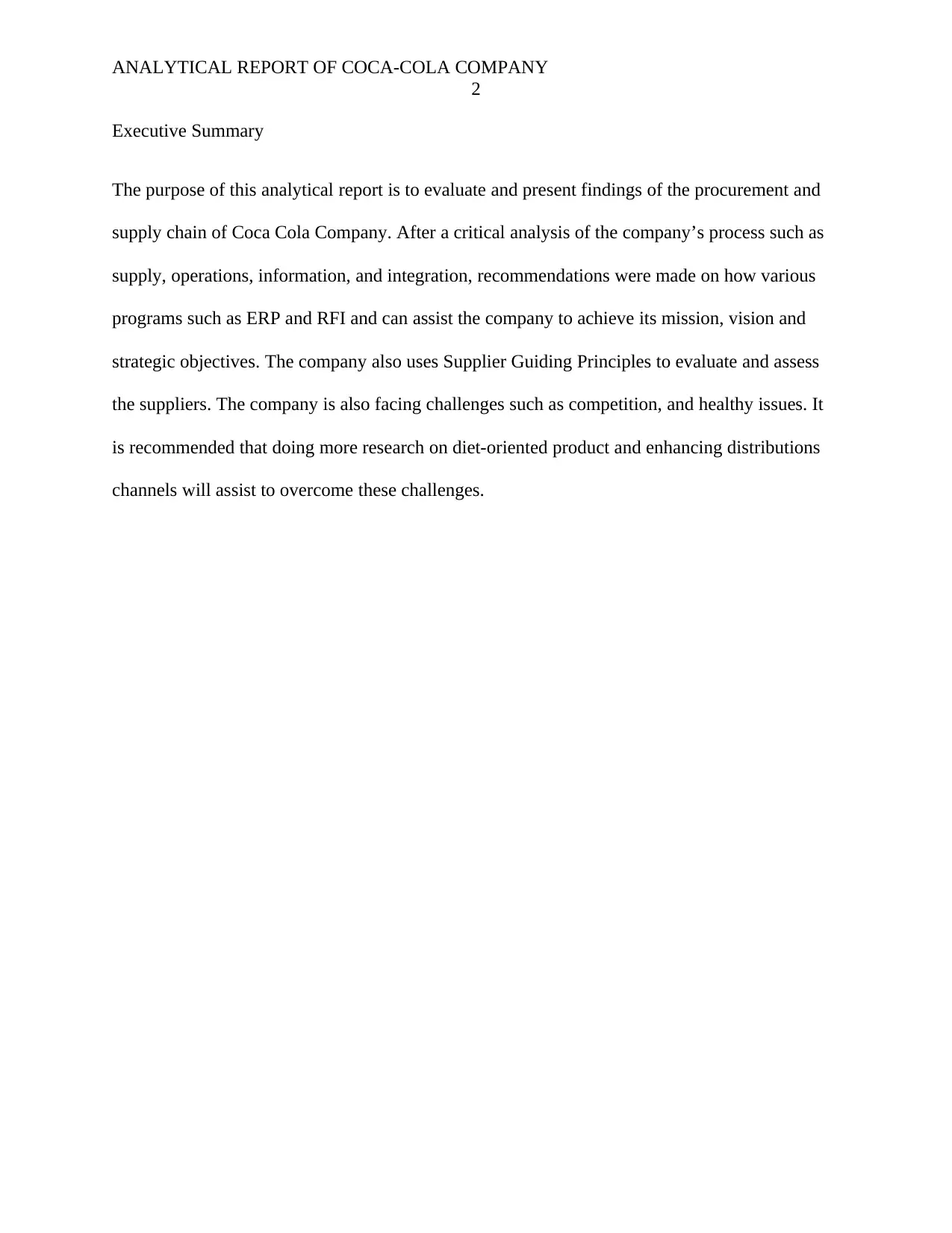
ANALYTICAL REPORT OF COCA-COLA COMPANY
2
Executive Summary
The purpose of this analytical report is to evaluate and present findings of the procurement and
supply chain of Coca Cola Company. After a critical analysis of the company’s process such as
supply, operations, information, and integration, recommendations were made on how various
programs such as ERP and RFI and can assist the company to achieve its mission, vision and
strategic objectives. The company also uses Supplier Guiding Principles to evaluate and assess
the suppliers. The company is also facing challenges such as competition, and healthy issues. It
is recommended that doing more research on diet-oriented product and enhancing distributions
channels will assist to overcome these challenges.
2
Executive Summary
The purpose of this analytical report is to evaluate and present findings of the procurement and
supply chain of Coca Cola Company. After a critical analysis of the company’s process such as
supply, operations, information, and integration, recommendations were made on how various
programs such as ERP and RFI and can assist the company to achieve its mission, vision and
strategic objectives. The company also uses Supplier Guiding Principles to evaluate and assess
the suppliers. The company is also facing challenges such as competition, and healthy issues. It
is recommended that doing more research on diet-oriented product and enhancing distributions
channels will assist to overcome these challenges.

ANALYTICAL REPORT OF COCA-COLA COMPANY
3
Table of Contents
Executive Summary…….…………………………………………………………………………2
Introduction..............................................................................................................................
…...4Mission, Vision, Goals……....
…………………………………………………………………….4
Findings of Supply Analysis………………………………………………………………………5
Findings of Operational Analysis…………………………………………………………………7
Findings of Information Analysis…………………………………………………………………9
Findings of Integration Analysis…………………………………………………………………11
Findings of Sustainability Analysis……………………………………………………………...13
Supply Chain Analysis…………………………………………………………………………..14
Improvement Programs………………………………………………………………………….14
Conclusion………………………………………………………………………………………15
References………………………………………………………………………………………16
3
Table of Contents
Executive Summary…….…………………………………………………………………………2
Introduction..............................................................................................................................
…...4Mission, Vision, Goals……....
…………………………………………………………………….4
Findings of Supply Analysis………………………………………………………………………5
Findings of Operational Analysis…………………………………………………………………7
Findings of Information Analysis…………………………………………………………………9
Findings of Integration Analysis…………………………………………………………………11
Findings of Sustainability Analysis……………………………………………………………...13
Supply Chain Analysis…………………………………………………………………………..14
Improvement Programs………………………………………………………………………….14
Conclusion………………………………………………………………………………………15
References………………………………………………………………………………………16
⊘ This is a preview!⊘
Do you want full access?
Subscribe today to unlock all pages.

Trusted by 1+ million students worldwide
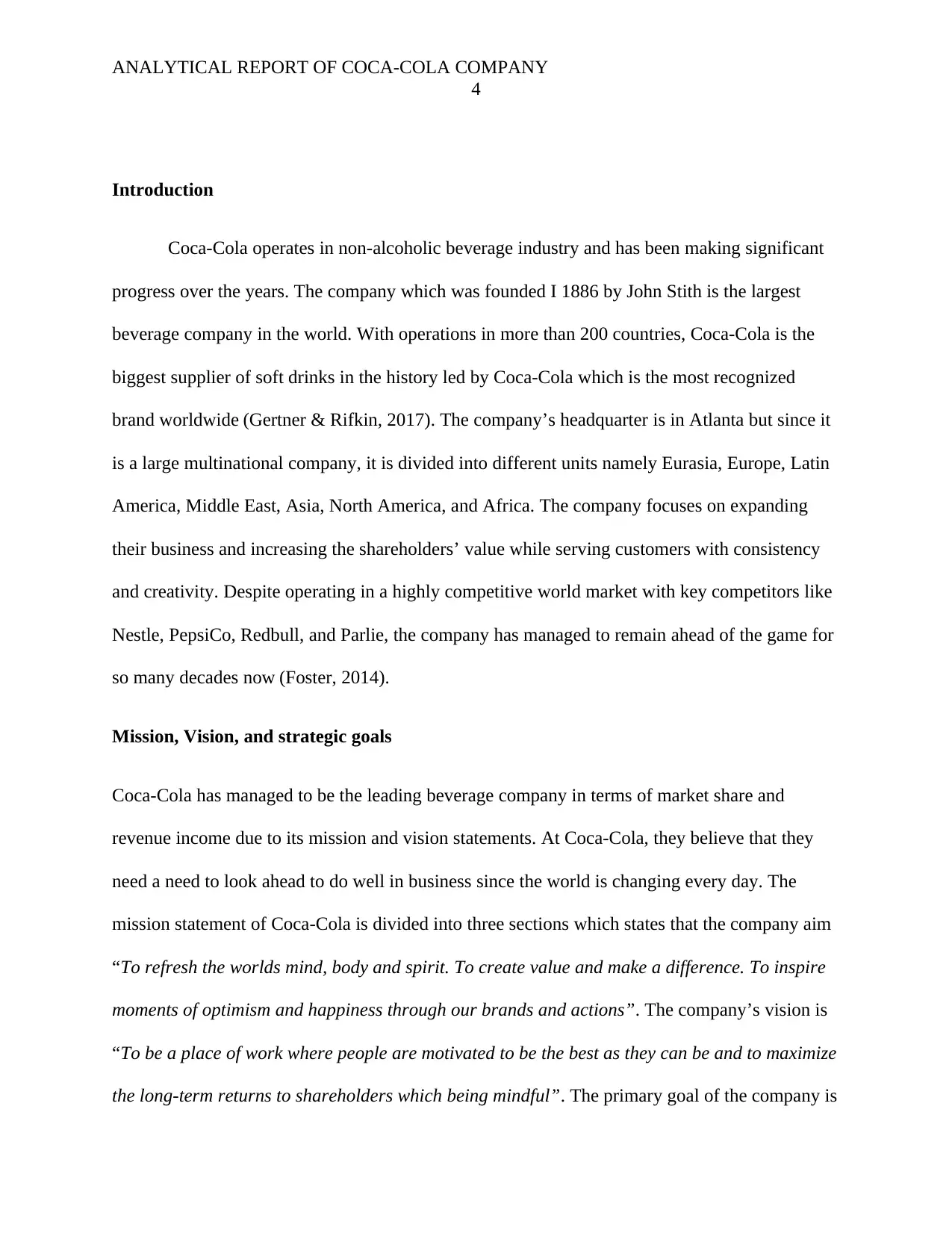
ANALYTICAL REPORT OF COCA-COLA COMPANY
4
Introduction
Coca-Cola operates in non-alcoholic beverage industry and has been making significant
progress over the years. The company which was founded I 1886 by John Stith is the largest
beverage company in the world. With operations in more than 200 countries, Coca-Cola is the
biggest supplier of soft drinks in the history led by Coca-Cola which is the most recognized
brand worldwide (Gertner & Rifkin, 2017). The company’s headquarter is in Atlanta but since it
is a large multinational company, it is divided into different units namely Eurasia, Europe, Latin
America, Middle East, Asia, North America, and Africa. The company focuses on expanding
their business and increasing the shareholders’ value while serving customers with consistency
and creativity. Despite operating in a highly competitive world market with key competitors like
Nestle, PepsiCo, Redbull, and Parlie, the company has managed to remain ahead of the game for
so many decades now (Foster, 2014).
Mission, Vision, and strategic goals
Coca-Cola has managed to be the leading beverage company in terms of market share and
revenue income due to its mission and vision statements. At Coca-Cola, they believe that they
need a need to look ahead to do well in business since the world is changing every day. The
mission statement of Coca-Cola is divided into three sections which states that the company aim
“To refresh the worlds mind, body and spirit. To create value and make a difference. To inspire
moments of optimism and happiness through our brands and actions”. The company’s vision is
“To be a place of work where people are motivated to be the best as they can be and to maximize
the long-term returns to shareholders which being mindful”. The primary goal of the company is
4
Introduction
Coca-Cola operates in non-alcoholic beverage industry and has been making significant
progress over the years. The company which was founded I 1886 by John Stith is the largest
beverage company in the world. With operations in more than 200 countries, Coca-Cola is the
biggest supplier of soft drinks in the history led by Coca-Cola which is the most recognized
brand worldwide (Gertner & Rifkin, 2017). The company’s headquarter is in Atlanta but since it
is a large multinational company, it is divided into different units namely Eurasia, Europe, Latin
America, Middle East, Asia, North America, and Africa. The company focuses on expanding
their business and increasing the shareholders’ value while serving customers with consistency
and creativity. Despite operating in a highly competitive world market with key competitors like
Nestle, PepsiCo, Redbull, and Parlie, the company has managed to remain ahead of the game for
so many decades now (Foster, 2014).
Mission, Vision, and strategic goals
Coca-Cola has managed to be the leading beverage company in terms of market share and
revenue income due to its mission and vision statements. At Coca-Cola, they believe that they
need a need to look ahead to do well in business since the world is changing every day. The
mission statement of Coca-Cola is divided into three sections which states that the company aim
“To refresh the worlds mind, body and spirit. To create value and make a difference. To inspire
moments of optimism and happiness through our brands and actions”. The company’s vision is
“To be a place of work where people are motivated to be the best as they can be and to maximize
the long-term returns to shareholders which being mindful”. The primary goal of the company is
Paraphrase This Document
Need a fresh take? Get an instant paraphrase of this document with our AI Paraphraser
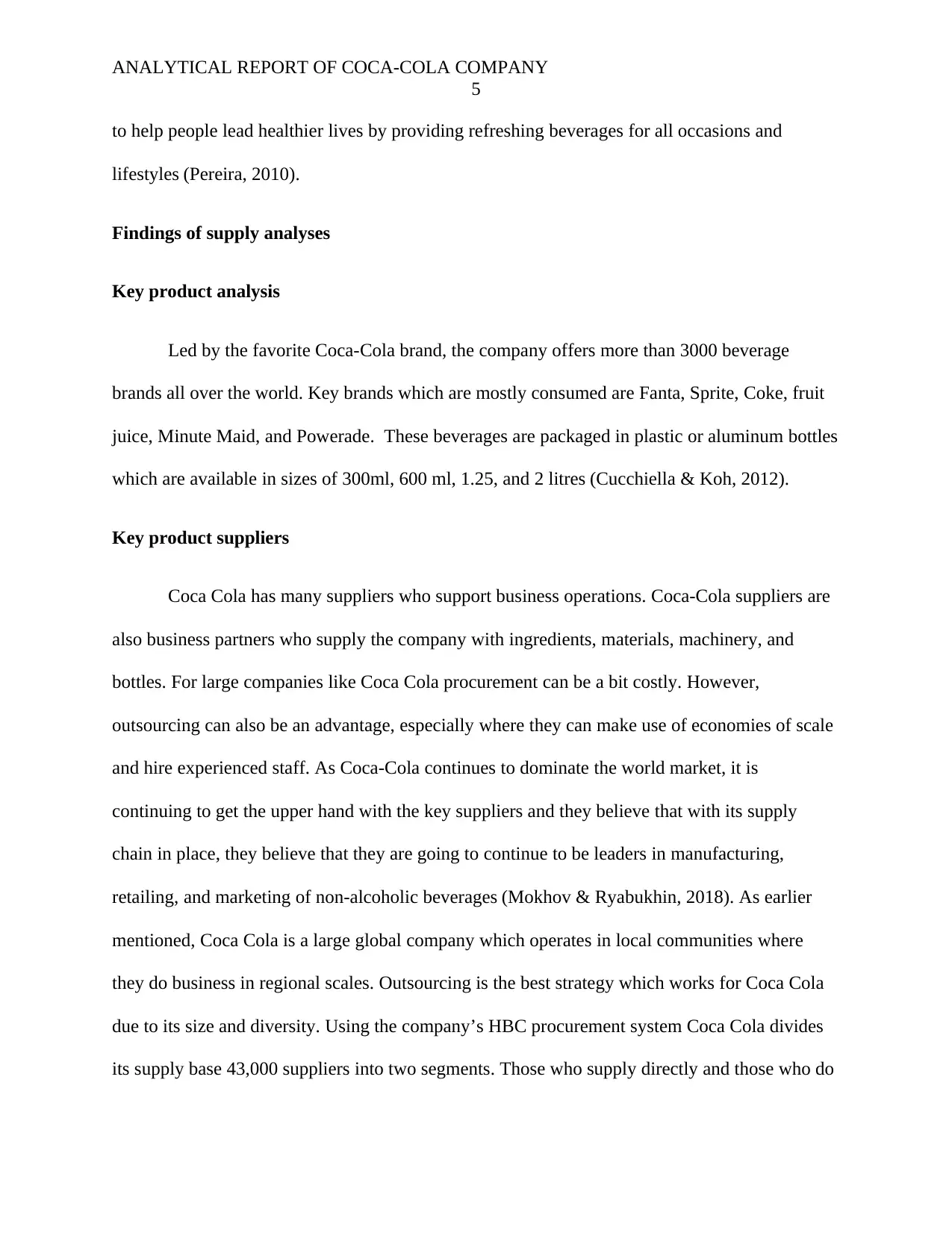
ANALYTICAL REPORT OF COCA-COLA COMPANY
5
to help people lead healthier lives by providing refreshing beverages for all occasions and
lifestyles (Pereira, 2010).
Findings of supply analyses
Key product analysis
Led by the favorite Coca-Cola brand, the company offers more than 3000 beverage
brands all over the world. Key brands which are mostly consumed are Fanta, Sprite, Coke, fruit
juice, Minute Maid, and Powerade. These beverages are packaged in plastic or aluminum bottles
which are available in sizes of 300ml, 600 ml, 1.25, and 2 litres (Cucchiella & Koh, 2012).
Key product suppliers
Coca Cola has many suppliers who support business operations. Coca-Cola suppliers are
also business partners who supply the company with ingredients, materials, machinery, and
bottles. For large companies like Coca Cola procurement can be a bit costly. However,
outsourcing can also be an advantage, especially where they can make use of economies of scale
and hire experienced staff. As Coca-Cola continues to dominate the world market, it is
continuing to get the upper hand with the key suppliers and they believe that with its supply
chain in place, they believe that they are going to continue to be leaders in manufacturing,
retailing, and marketing of non-alcoholic beverages (Mokhov & Ryabukhin, 2018). As earlier
mentioned, Coca Cola is a large global company which operates in local communities where
they do business in regional scales. Outsourcing is the best strategy which works for Coca Cola
due to its size and diversity. Using the company’s HBC procurement system Coca Cola divides
its supply base 43,000 suppliers into two segments. Those who supply directly and those who do
5
to help people lead healthier lives by providing refreshing beverages for all occasions and
lifestyles (Pereira, 2010).
Findings of supply analyses
Key product analysis
Led by the favorite Coca-Cola brand, the company offers more than 3000 beverage
brands all over the world. Key brands which are mostly consumed are Fanta, Sprite, Coke, fruit
juice, Minute Maid, and Powerade. These beverages are packaged in plastic or aluminum bottles
which are available in sizes of 300ml, 600 ml, 1.25, and 2 litres (Cucchiella & Koh, 2012).
Key product suppliers
Coca Cola has many suppliers who support business operations. Coca-Cola suppliers are
also business partners who supply the company with ingredients, materials, machinery, and
bottles. For large companies like Coca Cola procurement can be a bit costly. However,
outsourcing can also be an advantage, especially where they can make use of economies of scale
and hire experienced staff. As Coca-Cola continues to dominate the world market, it is
continuing to get the upper hand with the key suppliers and they believe that with its supply
chain in place, they believe that they are going to continue to be leaders in manufacturing,
retailing, and marketing of non-alcoholic beverages (Mokhov & Ryabukhin, 2018). As earlier
mentioned, Coca Cola is a large global company which operates in local communities where
they do business in regional scales. Outsourcing is the best strategy which works for Coca Cola
due to its size and diversity. Using the company’s HBC procurement system Coca Cola divides
its supply base 43,000 suppliers into two segments. Those who supply directly and those who do

ANALYTICAL REPORT OF COCA-COLA COMPANY
6
so indirectly. Agricultural ingredients are outsourced from multinational suppliers in various
countries including Hungary, Florida, Brazil, and Greece. Principal raw materials like sweeteners
are purchased from United States. The table below shows the major suppliers of Coca-Cola
Company (Foster, 2014).
SUPPLIER HEADGUARTER PRODUCTS &
SERVICES
Kraton Corp Texas, USA Biobased chemicals
and polymers
Crown holdings Pennsylvania,USA Beverage and food
cans
Pepsico Inc New York Food and beverage
Company
Eastman chemical co Tennessee, United
States
Additives, chemicals,,
and fibers
Omega protein Corp Texas, USA Dietary supplements
and animal feeds
Kralijic matrix is a tool used to analyze the purchasing strategies of a company. The tool
segments and prioritizes suppliers spending category by strengthening supply security while
reducing costs. At Coca-Cola, a Supplier Management Relationship process was invented
whereby the supplier risks and costs would be assessed. Supplier risks are rated using 13 factors
while potentials are assessed using 12 factors. The commodity which suppliers provide is the
factor used to analyze the suppliers' strength (Matthews et al., 2015).
6
so indirectly. Agricultural ingredients are outsourced from multinational suppliers in various
countries including Hungary, Florida, Brazil, and Greece. Principal raw materials like sweeteners
are purchased from United States. The table below shows the major suppliers of Coca-Cola
Company (Foster, 2014).
SUPPLIER HEADGUARTER PRODUCTS &
SERVICES
Kraton Corp Texas, USA Biobased chemicals
and polymers
Crown holdings Pennsylvania,USA Beverage and food
cans
Pepsico Inc New York Food and beverage
Company
Eastman chemical co Tennessee, United
States
Additives, chemicals,,
and fibers
Omega protein Corp Texas, USA Dietary supplements
and animal feeds
Kralijic matrix is a tool used to analyze the purchasing strategies of a company. The tool
segments and prioritizes suppliers spending category by strengthening supply security while
reducing costs. At Coca-Cola, a Supplier Management Relationship process was invented
whereby the supplier risks and costs would be assessed. Supplier risks are rated using 13 factors
while potentials are assessed using 12 factors. The commodity which suppliers provide is the
factor used to analyze the suppliers' strength (Matthews et al., 2015).
⊘ This is a preview!⊘
Do you want full access?
Subscribe today to unlock all pages.

Trusted by 1+ million students worldwide
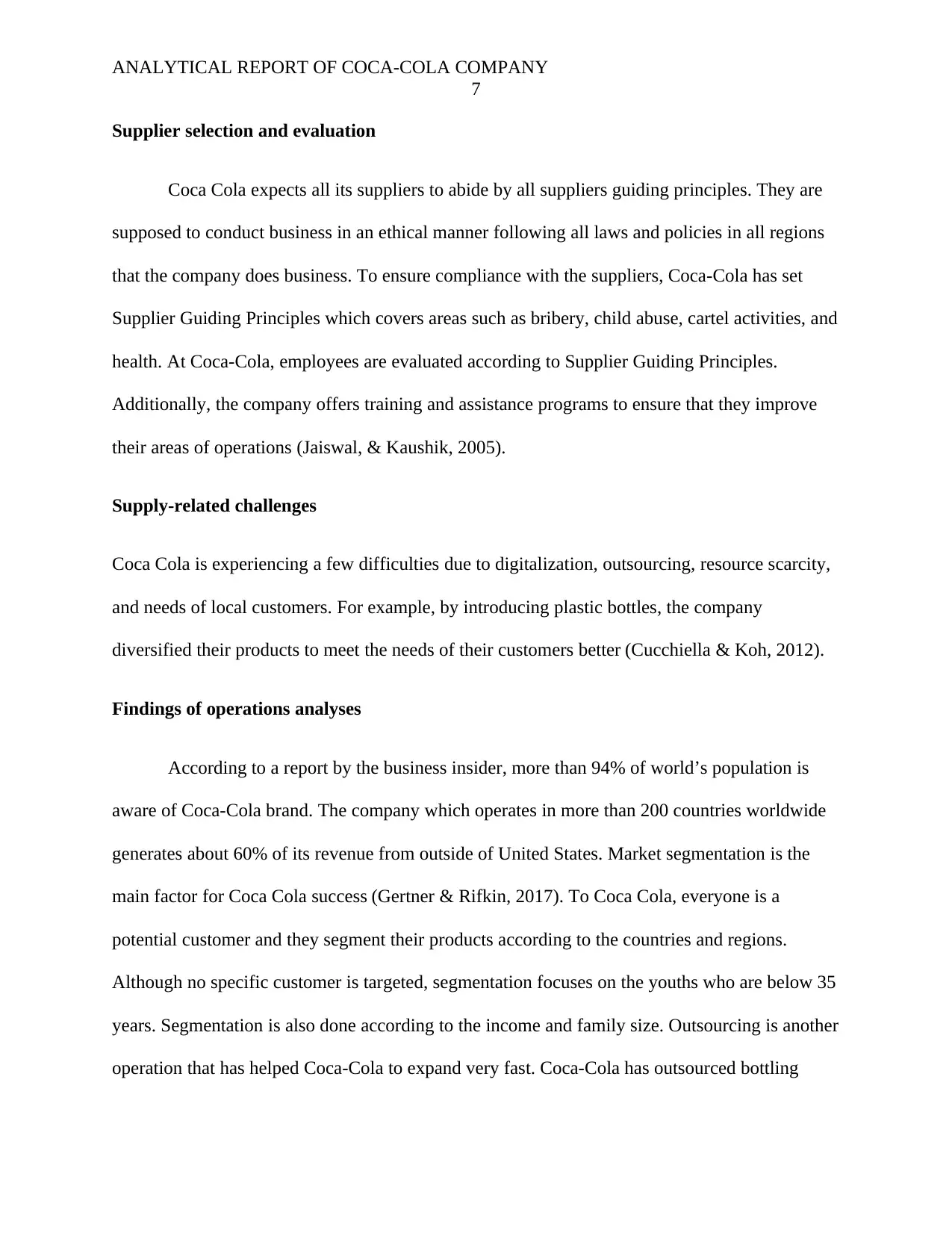
ANALYTICAL REPORT OF COCA-COLA COMPANY
7
Supplier selection and evaluation
Coca Cola expects all its suppliers to abide by all suppliers guiding principles. They are
supposed to conduct business in an ethical manner following all laws and policies in all regions
that the company does business. To ensure compliance with the suppliers, Coca-Cola has set
Supplier Guiding Principles which covers areas such as bribery, child abuse, cartel activities, and
health. At Coca-Cola, employees are evaluated according to Supplier Guiding Principles.
Additionally, the company offers training and assistance programs to ensure that they improve
their areas of operations (Jaiswal, & Kaushik, 2005).
Supply-related challenges
Coca Cola is experiencing a few difficulties due to digitalization, outsourcing, resource scarcity,
and needs of local customers. For example, by introducing plastic bottles, the company
diversified their products to meet the needs of their customers better (Cucchiella & Koh, 2012).
Findings of operations analyses
According to a report by the business insider, more than 94% of world’s population is
aware of Coca-Cola brand. The company which operates in more than 200 countries worldwide
generates about 60% of its revenue from outside of United States. Market segmentation is the
main factor for Coca Cola success (Gertner & Rifkin, 2017). To Coca Cola, everyone is a
potential customer and they segment their products according to the countries and regions.
Although no specific customer is targeted, segmentation focuses on the youths who are below 35
years. Segmentation is also done according to the income and family size. Outsourcing is another
operation that has helped Coca-Cola to expand very fast. Coca-Cola has outsourced bottling
7
Supplier selection and evaluation
Coca Cola expects all its suppliers to abide by all suppliers guiding principles. They are
supposed to conduct business in an ethical manner following all laws and policies in all regions
that the company does business. To ensure compliance with the suppliers, Coca-Cola has set
Supplier Guiding Principles which covers areas such as bribery, child abuse, cartel activities, and
health. At Coca-Cola, employees are evaluated according to Supplier Guiding Principles.
Additionally, the company offers training and assistance programs to ensure that they improve
their areas of operations (Jaiswal, & Kaushik, 2005).
Supply-related challenges
Coca Cola is experiencing a few difficulties due to digitalization, outsourcing, resource scarcity,
and needs of local customers. For example, by introducing plastic bottles, the company
diversified their products to meet the needs of their customers better (Cucchiella & Koh, 2012).
Findings of operations analyses
According to a report by the business insider, more than 94% of world’s population is
aware of Coca-Cola brand. The company which operates in more than 200 countries worldwide
generates about 60% of its revenue from outside of United States. Market segmentation is the
main factor for Coca Cola success (Gertner & Rifkin, 2017). To Coca Cola, everyone is a
potential customer and they segment their products according to the countries and regions.
Although no specific customer is targeted, segmentation focuses on the youths who are below 35
years. Segmentation is also done according to the income and family size. Outsourcing is another
operation that has helped Coca-Cola to expand very fast. Coca-Cola has outsourced bottling
Paraphrase This Document
Need a fresh take? Get an instant paraphrase of this document with our AI Paraphraser
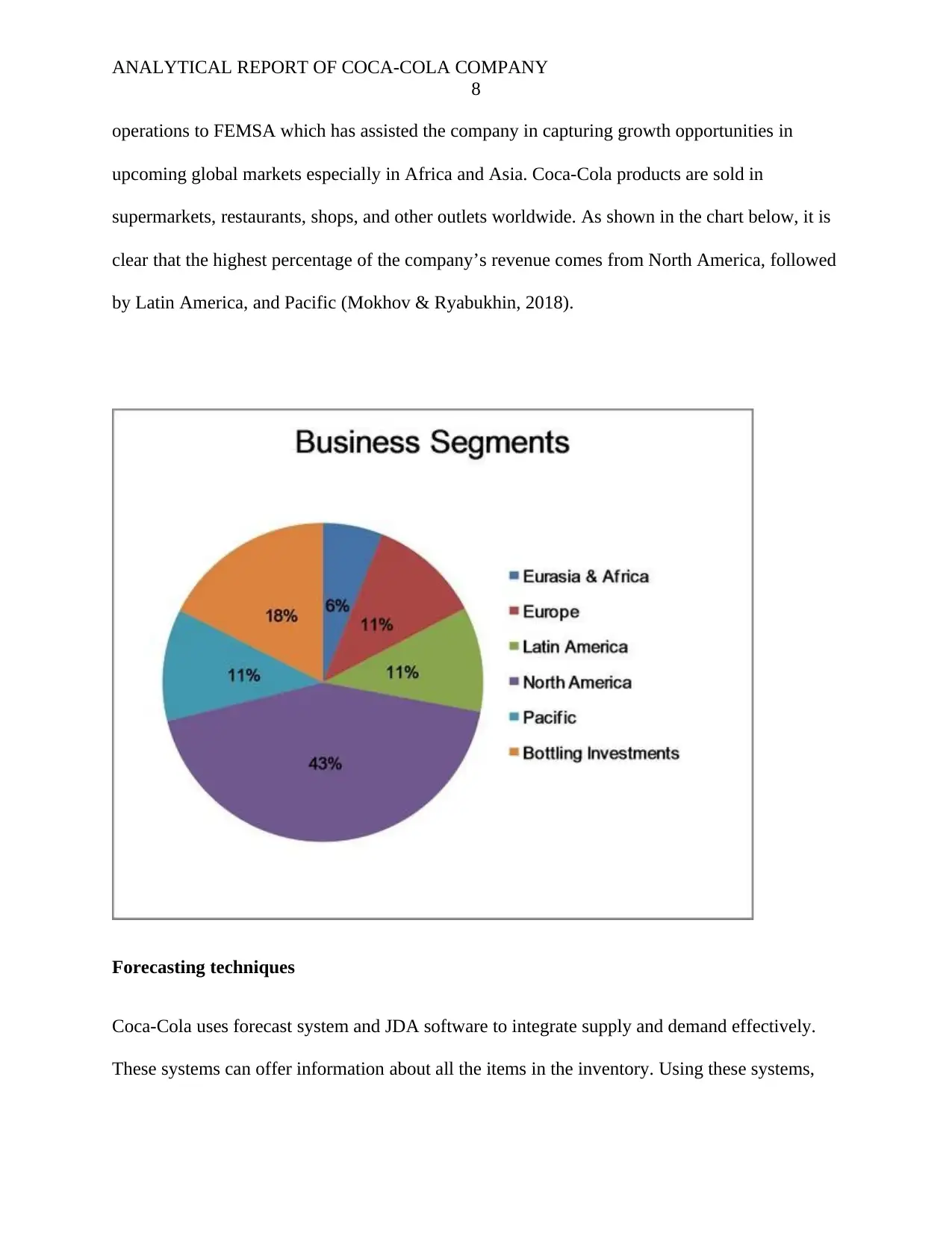
ANALYTICAL REPORT OF COCA-COLA COMPANY
8
operations to FEMSA which has assisted the company in capturing growth opportunities in
upcoming global markets especially in Africa and Asia. Coca-Cola products are sold in
supermarkets, restaurants, shops, and other outlets worldwide. As shown in the chart below, it is
clear that the highest percentage of the company’s revenue comes from North America, followed
by Latin America, and Pacific (Mokhov & Ryabukhin, 2018).
Forecasting techniques
Coca-Cola uses forecast system and JDA software to integrate supply and demand effectively.
These systems can offer information about all the items in the inventory. Using these systems,
8
operations to FEMSA which has assisted the company in capturing growth opportunities in
upcoming global markets especially in Africa and Asia. Coca-Cola products are sold in
supermarkets, restaurants, shops, and other outlets worldwide. As shown in the chart below, it is
clear that the highest percentage of the company’s revenue comes from North America, followed
by Latin America, and Pacific (Mokhov & Ryabukhin, 2018).
Forecasting techniques
Coca-Cola uses forecast system and JDA software to integrate supply and demand effectively.
These systems can offer information about all the items in the inventory. Using these systems,
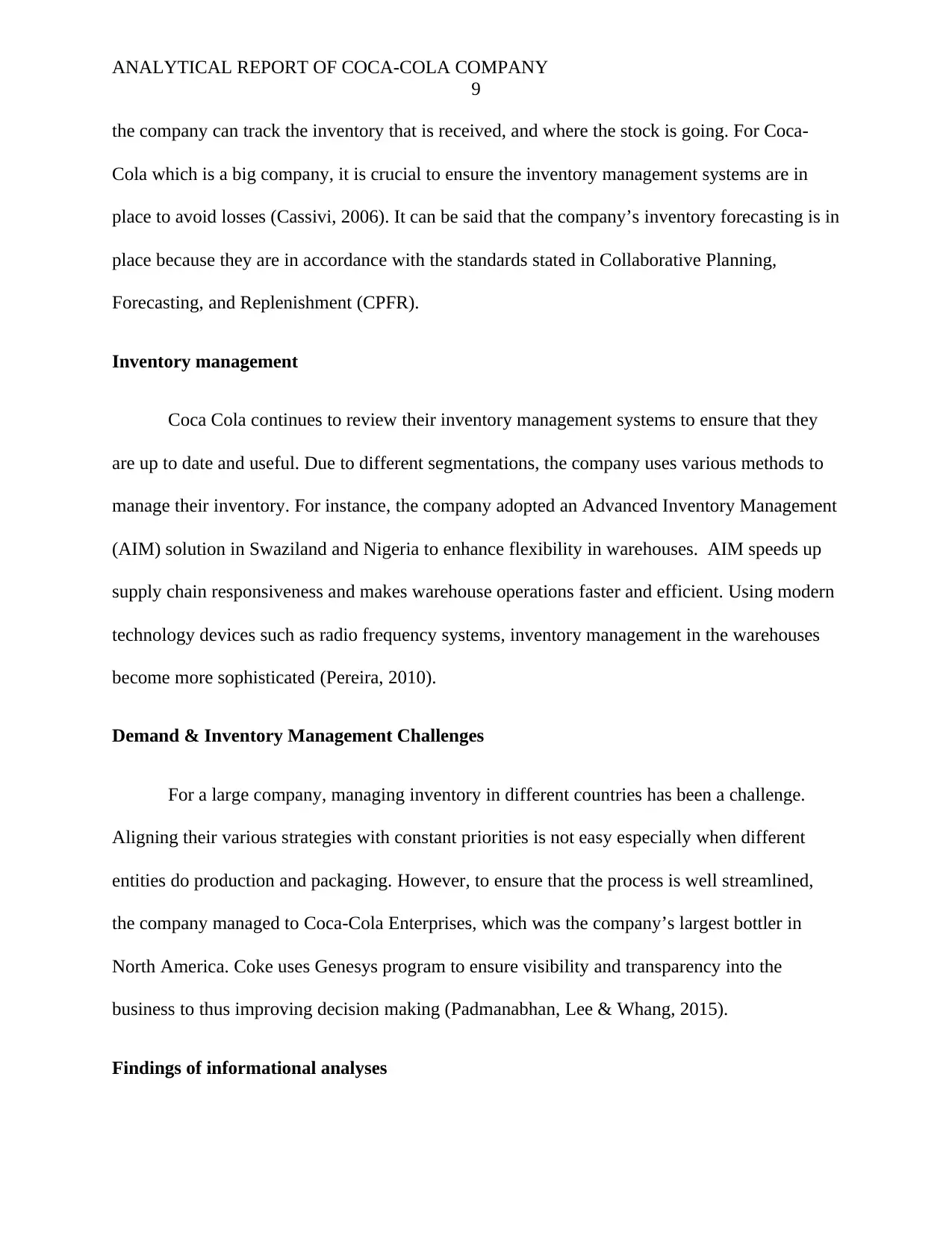
ANALYTICAL REPORT OF COCA-COLA COMPANY
9
the company can track the inventory that is received, and where the stock is going. For Coca-
Cola which is a big company, it is crucial to ensure the inventory management systems are in
place to avoid losses (Cassivi, 2006). It can be said that the company’s inventory forecasting is in
place because they are in accordance with the standards stated in Collaborative Planning,
Forecasting, and Replenishment (CPFR).
Inventory management
Coca Cola continues to review their inventory management systems to ensure that they
are up to date and useful. Due to different segmentations, the company uses various methods to
manage their inventory. For instance, the company adopted an Advanced Inventory Management
(AIM) solution in Swaziland and Nigeria to enhance flexibility in warehouses. AIM speeds up
supply chain responsiveness and makes warehouse operations faster and efficient. Using modern
technology devices such as radio frequency systems, inventory management in the warehouses
become more sophisticated (Pereira, 2010).
Demand & Inventory Management Challenges
For a large company, managing inventory in different countries has been a challenge.
Aligning their various strategies with constant priorities is not easy especially when different
entities do production and packaging. However, to ensure that the process is well streamlined,
the company managed to Coca-Cola Enterprises, which was the company’s largest bottler in
North America. Coke uses Genesys program to ensure visibility and transparency into the
business to thus improving decision making (Padmanabhan, Lee & Whang, 2015).
Findings of informational analyses
9
the company can track the inventory that is received, and where the stock is going. For Coca-
Cola which is a big company, it is crucial to ensure the inventory management systems are in
place to avoid losses (Cassivi, 2006). It can be said that the company’s inventory forecasting is in
place because they are in accordance with the standards stated in Collaborative Planning,
Forecasting, and Replenishment (CPFR).
Inventory management
Coca Cola continues to review their inventory management systems to ensure that they
are up to date and useful. Due to different segmentations, the company uses various methods to
manage their inventory. For instance, the company adopted an Advanced Inventory Management
(AIM) solution in Swaziland and Nigeria to enhance flexibility in warehouses. AIM speeds up
supply chain responsiveness and makes warehouse operations faster and efficient. Using modern
technology devices such as radio frequency systems, inventory management in the warehouses
become more sophisticated (Pereira, 2010).
Demand & Inventory Management Challenges
For a large company, managing inventory in different countries has been a challenge.
Aligning their various strategies with constant priorities is not easy especially when different
entities do production and packaging. However, to ensure that the process is well streamlined,
the company managed to Coca-Cola Enterprises, which was the company’s largest bottler in
North America. Coke uses Genesys program to ensure visibility and transparency into the
business to thus improving decision making (Padmanabhan, Lee & Whang, 2015).
Findings of informational analyses
⊘ This is a preview!⊘
Do you want full access?
Subscribe today to unlock all pages.

Trusted by 1+ million students worldwide

ANALYTICAL REPORT OF COCA-COLA COMPANY
10
Bullwhip effect
The purpose of a supply chain is to maintain the balance between production and customer
demand in the market (Pagell & Wu, 2009). However, sometimes keeping this balance may
prove to be challenging especially for multinational corporations which have a large customer
base. For complex networks such as those of Coca Cola, bullwhip effect can occur anytime in the
production process costing the company significant loss. To cope with this challenge, Coca Cola
uses a system called Black Book. Coca Cola uses this system for its Minute maid and Orange
brands to ensure that there is consistency when blending batches of orange. The system gives the
information required using algorithms by considering factors such as prevailing market cost,
weather, and crop yield. Using this information, the company can plan its supplies for
approximately 15 months ahead (Mokhov & Ryabukhin, 2018).
Key Information-Technology Tools
To maintain a lean and transparent supply chain, Coca Cola uses various integrated
technological systems. The Radio Frequency Identification technology is used to assess goods
coming or going out of the warehouses. ERP, SAP R/3, and IBM are some of the techniques that
are commonly used at Coca Cola. ERP is integrated with other systems to make information
more visible to suppliers about the estimated quantity they are supposed to supply. Moreover, 3
M technology is used to manage the warehouse processes (Kamariah & Mohamed, 2009).
Collaborative practices
Coca-Cola collaborates with WWF to provide sustainable agriculture. Basically, the purpose of
this collaboration is to conserve clean water and enhance better performance for targeted
10
Bullwhip effect
The purpose of a supply chain is to maintain the balance between production and customer
demand in the market (Pagell & Wu, 2009). However, sometimes keeping this balance may
prove to be challenging especially for multinational corporations which have a large customer
base. For complex networks such as those of Coca Cola, bullwhip effect can occur anytime in the
production process costing the company significant loss. To cope with this challenge, Coca Cola
uses a system called Black Book. Coca Cola uses this system for its Minute maid and Orange
brands to ensure that there is consistency when blending batches of orange. The system gives the
information required using algorithms by considering factors such as prevailing market cost,
weather, and crop yield. Using this information, the company can plan its supplies for
approximately 15 months ahead (Mokhov & Ryabukhin, 2018).
Key Information-Technology Tools
To maintain a lean and transparent supply chain, Coca Cola uses various integrated
technological systems. The Radio Frequency Identification technology is used to assess goods
coming or going out of the warehouses. ERP, SAP R/3, and IBM are some of the techniques that
are commonly used at Coca Cola. ERP is integrated with other systems to make information
more visible to suppliers about the estimated quantity they are supposed to supply. Moreover, 3
M technology is used to manage the warehouse processes (Kamariah & Mohamed, 2009).
Collaborative practices
Coca-Cola collaborates with WWF to provide sustainable agriculture. Basically, the purpose of
this collaboration is to conserve clean water and enhance better performance for targeted
Paraphrase This Document
Need a fresh take? Get an instant paraphrase of this document with our AI Paraphraser
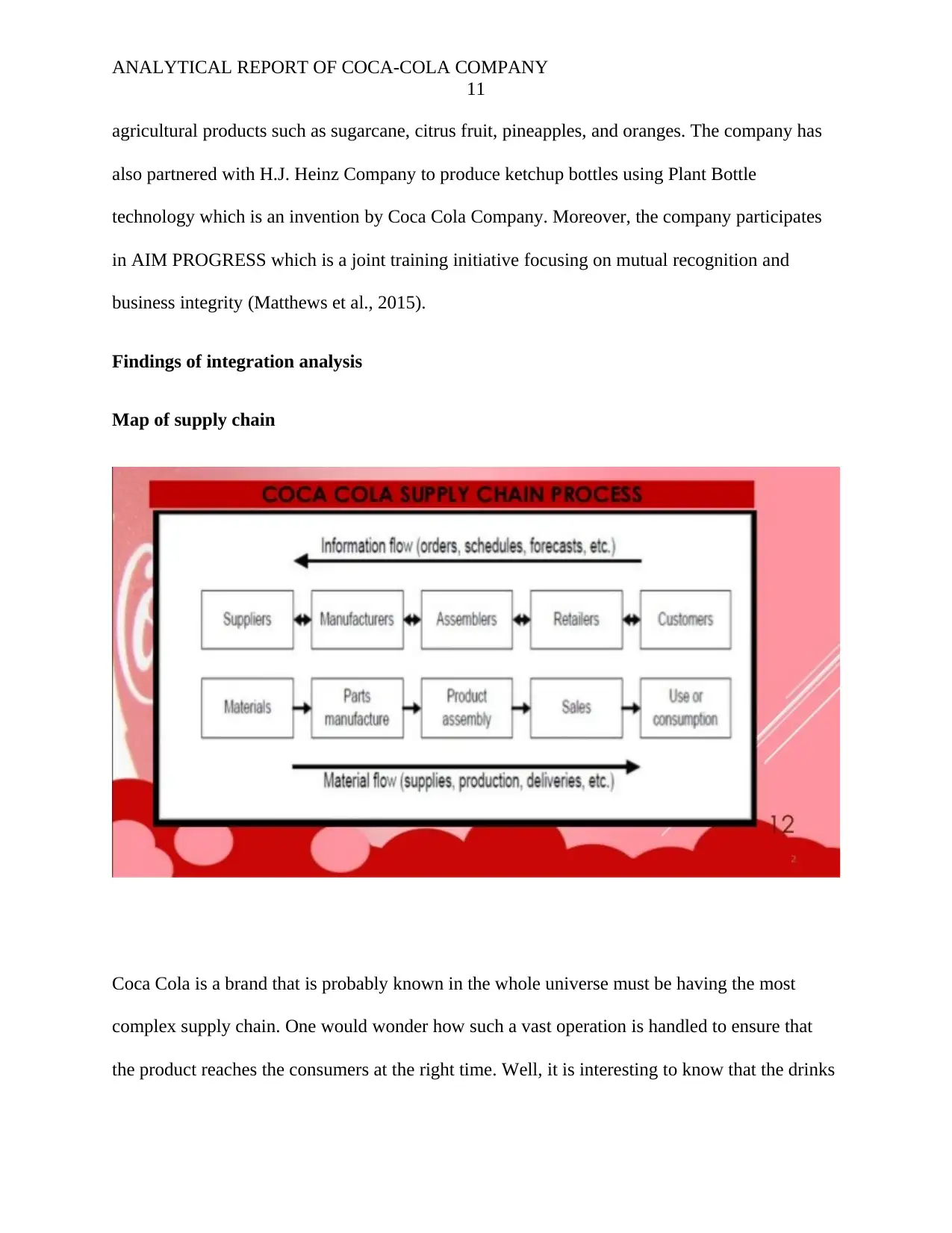
ANALYTICAL REPORT OF COCA-COLA COMPANY
11
agricultural products such as sugarcane, citrus fruit, pineapples, and oranges. The company has
also partnered with H.J. Heinz Company to produce ketchup bottles using Plant Bottle
technology which is an invention by Coca Cola Company. Moreover, the company participates
in AIM PROGRESS which is a joint training initiative focusing on mutual recognition and
business integrity (Matthews et al., 2015).
Findings of integration analysis
Map of supply chain
Coca Cola is a brand that is probably known in the whole universe must be having the most
complex supply chain. One would wonder how such a vast operation is handled to ensure that
the product reaches the consumers at the right time. Well, it is interesting to know that the drinks
11
agricultural products such as sugarcane, citrus fruit, pineapples, and oranges. The company has
also partnered with H.J. Heinz Company to produce ketchup bottles using Plant Bottle
technology which is an invention by Coca Cola Company. Moreover, the company participates
in AIM PROGRESS which is a joint training initiative focusing on mutual recognition and
business integrity (Matthews et al., 2015).
Findings of integration analysis
Map of supply chain
Coca Cola is a brand that is probably known in the whole universe must be having the most
complex supply chain. One would wonder how such a vast operation is handled to ensure that
the product reaches the consumers at the right time. Well, it is interesting to know that the drinks
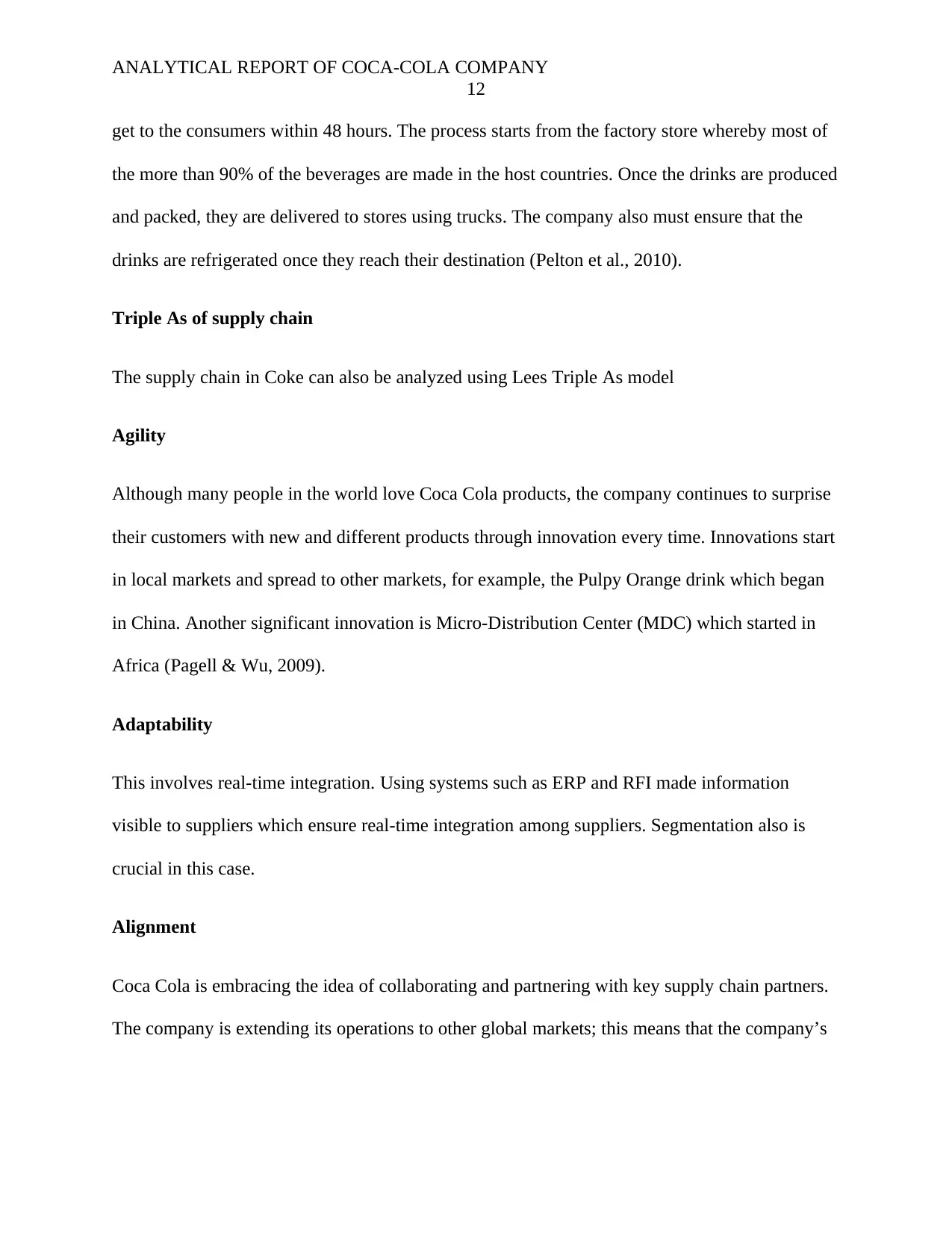
ANALYTICAL REPORT OF COCA-COLA COMPANY
12
get to the consumers within 48 hours. The process starts from the factory store whereby most of
the more than 90% of the beverages are made in the host countries. Once the drinks are produced
and packed, they are delivered to stores using trucks. The company also must ensure that the
drinks are refrigerated once they reach their destination (Pelton et al., 2010).
Triple As of supply chain
The supply chain in Coke can also be analyzed using Lees Triple As model
Agility
Although many people in the world love Coca Cola products, the company continues to surprise
their customers with new and different products through innovation every time. Innovations start
in local markets and spread to other markets, for example, the Pulpy Orange drink which began
in China. Another significant innovation is Micro-Distribution Center (MDC) which started in
Africa (Pagell & Wu, 2009).
Adaptability
This involves real-time integration. Using systems such as ERP and RFI made information
visible to suppliers which ensure real-time integration among suppliers. Segmentation also is
crucial in this case.
Alignment
Coca Cola is embracing the idea of collaborating and partnering with key supply chain partners.
The company is extending its operations to other global markets; this means that the company’s
12
get to the consumers within 48 hours. The process starts from the factory store whereby most of
the more than 90% of the beverages are made in the host countries. Once the drinks are produced
and packed, they are delivered to stores using trucks. The company also must ensure that the
drinks are refrigerated once they reach their destination (Pelton et al., 2010).
Triple As of supply chain
The supply chain in Coke can also be analyzed using Lees Triple As model
Agility
Although many people in the world love Coca Cola products, the company continues to surprise
their customers with new and different products through innovation every time. Innovations start
in local markets and spread to other markets, for example, the Pulpy Orange drink which began
in China. Another significant innovation is Micro-Distribution Center (MDC) which started in
Africa (Pagell & Wu, 2009).
Adaptability
This involves real-time integration. Using systems such as ERP and RFI made information
visible to suppliers which ensure real-time integration among suppliers. Segmentation also is
crucial in this case.
Alignment
Coca Cola is embracing the idea of collaborating and partnering with key supply chain partners.
The company is extending its operations to other global markets; this means that the company’s
⊘ This is a preview!⊘
Do you want full access?
Subscribe today to unlock all pages.

Trusted by 1+ million students worldwide
1 out of 18
Related Documents
Your All-in-One AI-Powered Toolkit for Academic Success.
+13062052269
info@desklib.com
Available 24*7 on WhatsApp / Email
![[object Object]](/_next/static/media/star-bottom.7253800d.svg)
Unlock your academic potential
Copyright © 2020–2025 A2Z Services. All Rights Reserved. Developed and managed by ZUCOL.





